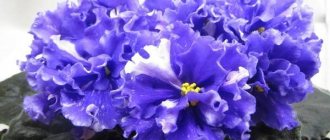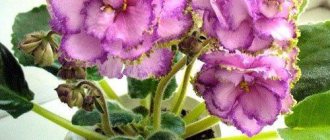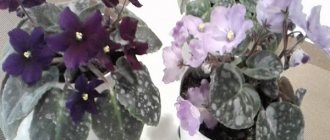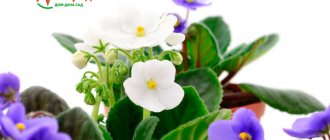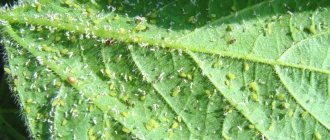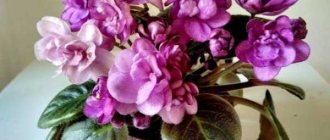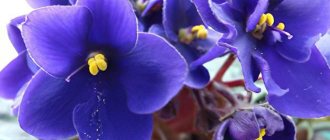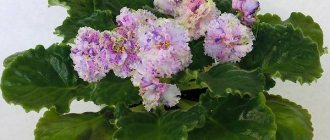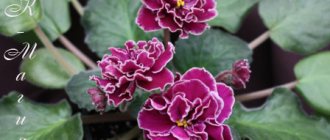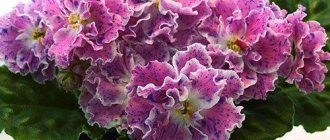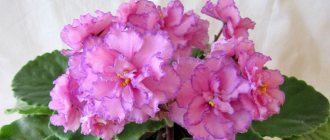Variegated Violet is very loved by many gardeners for its beauty and unusual appearance. The flower continually surprises with its charm. These violets come in a variety of varieties; they are suitable for landscape design, as well as for home decoration, photo shoot areas, summer cottages, and will also add beauty to greenhouses.
By its appearance we can say that the Variegated Violet flower is amazing and attractive. Judging by the color, we can say that the plant is also diverse, there may be the usual green tint, but there may be yellow, ocher and fuchsia, you can also find a plant with white leaves.
Violet Variegated: variety description and characteristics
Variegated violet: photo of variety
Experts have long wondered why there is such an unusual and varied color on violet leaves? This is because the plant reproduces from its own seeds and the creation of new ones occurs, mutation of flowers.
The birthplace of the variegated violet is the United States of America, the mid-twentieth century. The plants developed variegated immediately, and this could not be removed in any way. Initially, violets have one or a couple of leaves of different colors. Thus, the flower was not popular at gardening gatherings because no one knew what color it would be when it grew.
It must be said that after such exhibitions, the plant variety was given a new name “Spontaneous Selection”. Variegated leaves were rarely passed down from generation to generation. Their color, it always changes, reaches a dense green.
This mutation occurs at high humidity and temperature in the room where violets are grown, as well as due to the large amount of nitrogen in the nutrients. Varieties of color can be as follows: soft pink, acidic, ocher.
Variegated violet: varieties with names and photos
Variegated violet: photo of variety
At the moment, we can already count up to four thousand different types of violets. Experts studied a large number of variegated leaves, even created a magazine with violets, which shows the three main types of plants:
- Tommy Lowe Variegation is the name of the plant after its creator. Most of the leaves are green in color, along the edges there is a small outline from yellow to pinkish. The color of the plant may be different, depending on the growing conditions. Light is not dangerous for this violet due to its large accumulation of chlorophyll. It can be propagated by cuttings, like all flower varieties. This method allows for rapid reproduction, all on time.
- Crown variegation is not such an attractive crop. The leaves are pale, green, sometimes pink in color, as the inflorescence passes, the leaves disappear, and new ones appear in place. The peculiarity of violets is that the leaves closer to the ground are a green, uniform, dense color, and those that grow higher can be yellow. It can also be propagated by cuttings. This plant requires special and regular care. They always need lighting, and when they reproduce, the babies need more warmth and moisture.
- Mosaic variegation is an exception flower, a miracle of nature. It can be found in exceptional places, that is, it is not a common plant like the others. On its leaves you can see spots, bright in color, not only of older, but also of younger plants. The shade of the leaves of this violet can be varied at one time. In order for the plant to be comfortable, it is grown at temperatures from eighteen to twenty-five degrees, it is imperative to ensure that there is a lot of light. Also, the flower does not tolerate hot weather, so it should be moistened. The inflorescence appears later, not like other violets.
- Chimera - this variety has a clear pattern on all leaves. The pattern on the leaves can be dull or bright. This variety is not common, because its propagation is possible only by stepsons that form directly in the flower. But their heredity is not exact. The peculiarity of the plant is in its composition. Under a microscope you can see that the petals are two-layered, one green is the main one, and the other seems to be superimposed on top - light green.
Togliatti breeder Elena Korshunova about her favorite violets
To be happy, you must have a hobby or business that will help you feel like a creative person, a creator. This is why many people sing, compose music, learn to play various instruments, paint pictures, plant gardens, etc. The joy of creativity brings with it success and recognition, because it is impossible not to notice the seen, felt and recreated beauty that the creator shares with us.
Our guest today is Elena Korshunova, a famous Togliatti breeder. Most recently, the local history museum hosted an exhibition and sale of her violets, where varieties were presented that became winners of Russian and international violet exhibitions.
photo: “Freedom Square”
— Elena, please tell the readers of our newspaper about how you realized your calling?
— I have loved flowers since childhood. Ever since school, I have been interested in growing indoor and garden flowers with my own hands. I constantly brought home different cuttings and grew indoor flowers from them. She loved going to a flower shop; she could spend hours looking at the plants. Once (back in the 70s) I bought a blooming Persian cyclamen. He seemed so beautiful to me that I constantly admired him! Even when I was already studying at the institute and living in a dormitory, I managed to grow flowers in my room.
— Violet selection is my main hobby, which brings joy and satisfaction. Breeding new varieties is my favorite thing, but my husband and I have a completely different business, and I have a higher technical education.
— How long have you been engaged in selection?
— In the mid-90s, the first varietal violets appeared in my home collection, and I began to cross them. I had a dream to get a red large-flowered variety. Of the red-flowered varieties at that time, there was only one variety - Arapaha, but it did not have large enough flowers and was very bushy. Knowing that the red petal color of violets is a recessive trait that can only appear in the second generation, I had to carry out a chain of crosses to obtain a large-flowered red variety. Only a few years later I received such a variety and called it “EK - Bullfight”. It has huge (up to 7 cm in diameter) double red flowers. This variety created a real sensation in the violet world and became the ancestor of many red-flowered varieties.
— What exhibitions did you participate in?
— Collectors of violets constantly invite me to their exhibitions in Moscow, St. Petersburg, and other cities. I went to exhibitions in Moscow several times, and in recent years I have been holding my own exhibitions in our city. My varieties are widely known among collectors in Russia, Kazakhstan, Ukraine, Belarus, Georgia, Armenia, America, Sweden, Poland, Germany, China and other countries. Many violet growers grow them and present them at exhibitions in their cities, where they often take prizes.
— How long does it take to develop a new variety?
— To develop and consolidate a new variety, it takes at least 3 years, and often more. First you need to set a goal based on which to select parent pairs. Outline a chain of crosses, taking into account all dominant and recessive traits, and also take into account, if possible, hereditary traits. Pollen is taken from the father plant and transferred to the stigma of the mother plant. After crossing, a fruit is formed - a capsule that ripens from 6 to 9 months. There are up to 150 tiny seeds in a box. Then there is a long process of growing seedlings and bringing them to flowering. And when the seedlings bloom, the culling process begins, and many of them have to be thrown away as uninteresting. Interesting seedlings need to be replanted and continue to observe them and draw conclusions, taking into account the shape of the leaf rosette, the strength of the peduncles, the richness of the color, the abundance of flowering, and the repeatability of varietal characteristics during vegetative propagation. Often it is necessary to carry out crosses between the resulting selected seedlings in order to “pull out” some recessive trait. Like the red color of the EK variety - Bullfight.
— In a word, the process is very labor-intensive and painstaking. What is needed, for example, to achieve a certain color of stripes on flowers?
— To get stripes on a flower, one of the parents must have a fancy color. Fantasy color is when on the main background of the flower there are dashes and touches of a different color, for example, on a blue background there are blue splashes.
- It’s incredibly beautiful, simply mesmerizing! Considering that violets themselves are very delicate flowers. Do you have your favorite varieties?
— I have a lot of favorite varieties of violets. I especially like large-flowered varieties, such as EK - White Queen, EK - Bullfight, EK - Tender May, EK - Blue-Eyed Russia and many others. By and large, they are all loved and beautiful, like creations of nature.
— How do you come up with names that are so beautiful and poetic?
— I read a lot and write down beautiful phrases that I like. For example, "Moon in Love." When I develop a new variety, and I have several hundred of them, I leaf through my thick notebook and choose a name. And sometimes, when I look at a blossoming flower, some associations come, a basic word is selected that brings with it other epithets, you come up with a name for a new creation, which is always beautiful. How can flowers not be beautiful?
— Are there any signs in the selection? Is a “light hand” needed or is it prejudice?
— I have no signs of working with flowers. And I believe that the main thing is not a light hand, but knowledge of the needs of any plant and the ability to satisfy them. We must not forget that the violet is not an interior item, but a living organism that needs sunlight, warmth, water and care.
- Do you think flowers can love or not love a person?
— A flower cannot love or not love a person, but it requires attention, like any living creature. If someone does not have the diligence, knowledge, desire or ability to create favorable living conditions for him, then it is better for such a person to decorate his interior with artificial flowers. This is also beautiful, but not so responsible.
Interviewed by Larisa Agisheva, Freedom Square newspaper
Variegated Violet: care
Variegated violet: photo of variety
To preserve the color of variegated violet petals, you need to know some criteria:
- Violet soil needs to have some nitrogen in it, unlike other soils for growing the plant.
- Lots of light. You can add additional lighting, but it should not be direct, because some leaves may burn in direct rays.
- Room temperature - some plants do not like hot weather, for example, at high temperatures above twenty-eight degrees the petals fade.
The upper leaves are less adapted to life because they contain little chlorophyll. Thus, in order to better propagate the plant, it is necessary to use leaves that are closer to the ground.
It happens that the plant is completely variegated, it needs to be fed with nitrogen and useful substances so that the plant becomes stronger.
November
It’s cloudy and uncomfortable outside... Again, rain, rain, rain... I’m probably not the only one who has a wish that the snow would fall soon! Such an endless autumn this year! I didn’t get to enjoy the colorful dance of fading nature. There were almost no sunny days.
Dear violet like-minded people, I began to have seditious thoughts: “Shouldn’t I get rid of some very significant part of the household, leaving only what I can’t live without!” This kind of sedition is visiting me more and more often, is it the weather that is affecting me this way or some other misfortune has happened?!
Having once again started sanitary cleaning on the window sills, I noticed that everything was not right. There's a blooming one, and three days later it's not blooming - it's all mixed up. I decided to gather everyone together on one windowsill. And somehow my soul felt warmer. I placed everything in my room at eye level. The flowering is not like summer, but in my opinion it’s not bad, and most importantly it makes me happy.
Summer Twilight (Morev) There is an opinion that the first flowering does not mean anything. I think that this starter said a lot, it’s a pity that the end of the flowering season (window sills, after all). If it were spring and the rosette would have the opportunity, under normal light conditions, to grow foliage and bloom again…. I really want to see her in good health in the spring!
The flowers are super double!
This is the dead guy I saved from the heat in the summer.
YAN-Minuet. Starter. Flowering is also abundant (for a starter. There are adult rosettes of some varieties, the flowering of which is sparse)
Blue Dragon: bloomed modestly after replanting with the removal of the lower rows of leaves and cutting the earthen ball with roots into half.
Mac's O' Scarlet
O
'
Hara:
Lemon Kisses: Always a friendly bloom, it's just a shame that the flowers don't last long. I didn't wait for complete dissolution. It just doesn't make sense. Some fade, others bloom.
EK-Lambada: Finally, my patience has been crowned with success! I received the order at the beginning of June last year. My long-awaited one!
A very modest rosette, and the flowering is modest, but at least now I know what the variety is. The variety probably won’t cause much delight. (After all, there are just bombs!) All the charm is in a gentle, non-intrusive, modest form. I like it. All that remains is to trim the socket (it burned a lot of sheets while on the balcony and had to be removed)
EK-Blessing: I know I showed it, but it’s blooming, and why not? Moreover, this is a different outlet.
Storm's Eye: Starter. My flower stalks are disheveled as always.....
But if you choose the right angle…….
Pink Amiss: Another long-term construction... Not impressive because it’s still too young to bloom.
LE-Linda: It was not replanted, it stood forgotten, and blossomed again.
It needs to be replanted, but not everyone will get around to it.
There is a starter of the same variety, blooming as it should in the description. All hope lies in him. My cat almost killed it for me. I still can’t wash it off and shake it off the soil. I take care of it as I saw it bloom according to the rules...
RS-Cabaret: Starter. I personally was not impressed by the flowers of this variety, but their quantity is a big plus. (I'm talking about an adult plant, not this one specifically)
EK-Gift for Christmas: sorry for the unsightly appearance. In the summer I was re-rooting. Now there is a lack of light. The rosette has not recovered, but is trying to bloom.
LE-Flamenco: Also after the transplant. Not all of the buds have blossomed, it’s worth plucking them off, of course, so as not to drain the outlet, which I’ll probably do.
Lyon
'
s Plum Pudding
The rosette doesn't grow for some reason.
Fredette's Risen Star: Starter
In a whisper….. in a barely audible whisper…Live Wire. Well, I can’t imagine where I got it from, paired with the Variegated Bird. Well, I threw everyone out a long time ago. An-no Disguise and... voila!
Forgive me for the many photos of the same type, it was very difficult to choose a photograph. And I’m also sorry for the different caliber of photographs. The camera was covered, everything was filmed on the phone.
I would like to note the fact that variegation has begun to appear on those who are supposed to have it. Although the house is still warm.
The le-na-pra tradition didn’t work out because it got dark. But it looks something like this.
